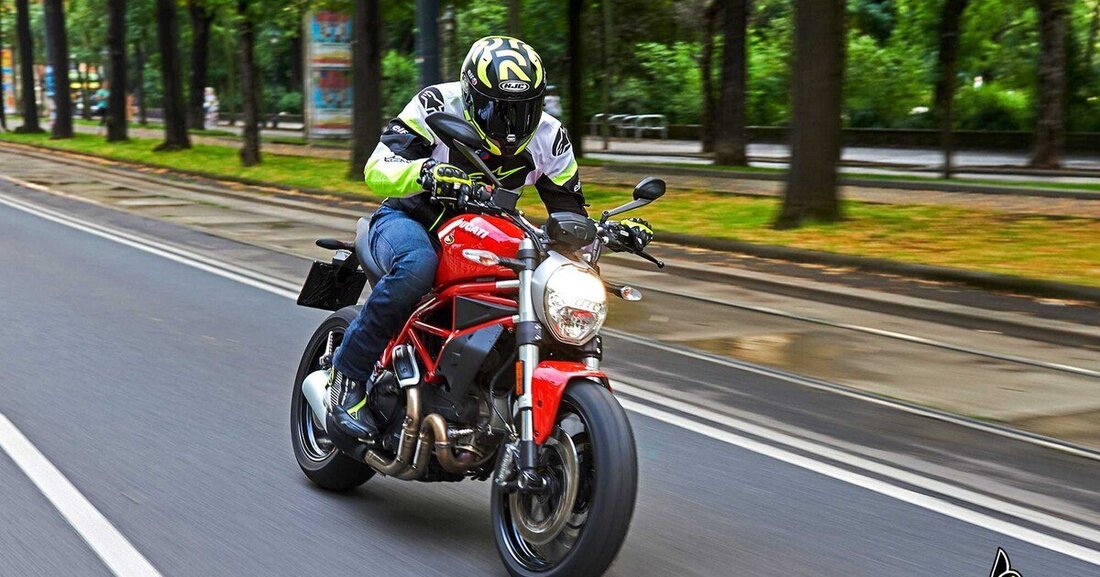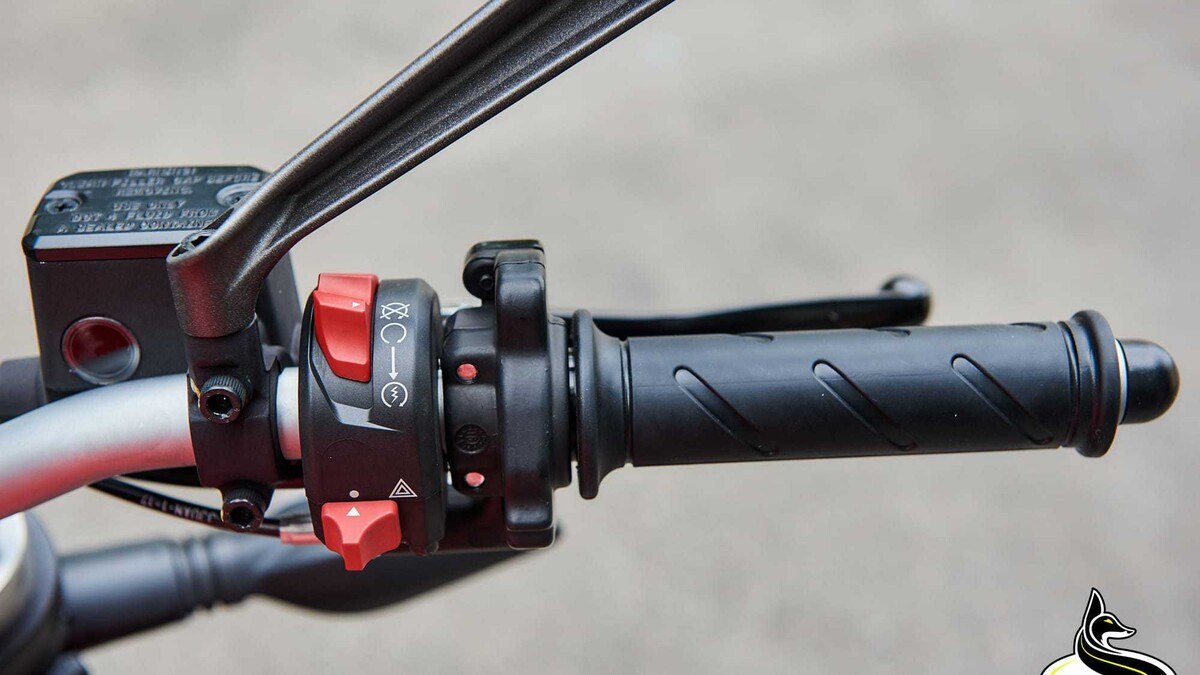Test Ducati Monster 797 – The subtle hubris
Ducati's new entry into the Monster family has returned to its roots: 90-degree two-cylinder with air cooling and two-valve technology. The price is a confident announcement at 10,490 euros. Can the Italian score points or does she see no place against the competition? The test was an ordeal.

Test Ducati Monster 797 – The subtle hubris
ergonomics
Since I switched directly from the Ducati Supersport 939 to the Monster 797, getting on the bike for the first time was full of surprises: the handlebars are wide and high. Gone are the days when the Duc Monster stretched you comparatively low over the tank. Close to the handlebars, you sit with your upper body upright, just like on the Yamaha MT-09. The knee closure is typical Ducati: perfect. The seat height of 805 mm feels lower thanks to the narrow tank; you have a comfortable stance, even without straight legs. The footrests are comfortably positioned and the knee angle is relaxed. But I have to get used to the wide, straight handlebars. Typical Monster: If you look slightly downwards, you can see the slightly larger, fully digital speedometer but nothing of the front wheel, even though the headlight is extremely flat. The strongly front-wheel-oriented but still upright seating position gives me a certain unicycle feeling, which was confirmed after the first few corners. The standard test monster weighed exactly 200 kg. The weight distribution is 96 kg on the front wheel and 104 kg on the rear wheel. It doesn't have a windshield, but the wind protection was fine (for a naked bike) on the highway.
Handling
In the first corner I bolted almost inside over the edge plate. Jesus, that’s tippy! The direct contact with the front wheel and the wide handlebars make the little monster appear hyper-agile, especially at low speeds. Only at slightly higher speeds (from around 40 km/h) does the steering behavior become more neutral and predictable. Something I didn't know from the previous version. The steering behavior reminds me a lot of the first generation of the Ducati Hypermotard. But that's only a limited compliment, because this extreme light-footedness has led some hyper riders to dismount over the front wheel. Of course, the Monster is anything but “dangerous”, but unsettled, passive novice drivers could find beads of sweat on their foreheads in hairpin bends. Don't worry, the Pirelli Diablo Rosso II tire has enough grip, but you can tell that the Monster 797 prefers the faster radii. From around 40 km/h, the red Italian swings through the curves stably and with a pleasant amount of feedback. Changing direction is easy thanks to the wide handlebars and there is no high-speed commuting at all. And even when leaning, line corrections are still possible, even on the brakes. If the handling in slow corners weren't so wobbly, I would describe the Monster as a sporty, stable device.
Engine/gearbox
Let's talk Tacheles: two-cylinder, 803 cubic meters, 73 hp, 67 Nm. Hmmm. The raw numbers don't blow me away. By the way, the engine is familiar from the Ducati Scrambler. You still get in a good mood while driving. On the one hand, the engine sounds like a real Ducati (in its original condition), despite Euro 4. On the other hand, you can feel that the engineers have done their homework, because the smoothness at low speeds is surprisingly good. It wasn't always like that with the Ducs. The monsters are not familiar with chain whips and jerking. The throttle response (no different maps, no traction control) is unremarkable. Basically, the engine is discreetly lively. Surprising: Even though it's a two-valve engine, there's even a slight performance boost at the top. The 73 hp and 67 Nm are still not a brutal wrecking ball, but a rock-solid, fun country road engine. Subjectively I would have guessed around 80 hp, the torque is particularly present in the middle. However, a few days later I found my note: “Engine unspectacular”. The gearbox was completely inconspicuous, but I think the gradation was very successful for everyday use. 6th gear is short enough to still feel acceleration, but long enough to drive at comparatively low, fuel-saving speeds on the highway. The cable clutch is precise and very easy to control. And the APTC clutch in the oil bath reliably prevents rear wheel stamping.
Undercarriage
Disillusionment is second: The 43 mm Kayaba USD fork is not adjustable, but the Sachs shock absorber is adjustable in rebound and spring preload. But honestly: for a bike that costs over 10,000 euros, that's not enough for me. The fork should be able to do a little more. But that doesn't change the fact that the setup for country roads is a success. Even under hard braking, the fork does not dive with underdamping or even lock up. Gone are the days when the Ducs were buttery soft at the front and over-damped at the back. The Monster is balanced and presses into the suspension travel equally at the front and rear. Short, hard hits are noticeable in the handlebars, but the Monster holds the line. Rocking when there are several bumps in a row or when driving faster is hardly noticeable. What remains? The impression is that despite the comparatively simple chassis, the performance is good. I wouldn't have expected that.
Brakes
And this is where the competition gets its slap: The Monster comes with Brembo M4.32 monoblock brake calipers at the front, which bite into huge 320 mm brake discs. This is the finest braking hardware. Only the axial brake pump spoils the overall impression a little, but overall the brake is really good. The feedback on the brake lever is pleasantly direct but not super snappy. The first brake bite is a bit tame, but becomes more transparent as the pressure increases. The ABS kicks in noticeably, but for me - as is often the case - sufficiently late and not too hectic. The rear wheel brake is great: perfectly modulated and with a surprisingly strong braking effect. If you have a smooth, “let it go” driving style, you will probably only be able to get by with the rear wheel brake. So it's very clear: the braking system is beyond any doubt. Class.
Noticed
Visually appetizing mirrors that reveal something even at higher speeds. The good light of the headlight. How long you can easily balance on your motorcycle even when standing at a traffic light. The very comfortable bench – so they would have taken a mold of my seat and carved it into a saddle. The cultivated engine. On the right, the engine block is comparatively wide; I was constantly standing in line with my boots. And the right thigh is literally grilled by the waste heat from the strange manifold routing in the city.
Failed
The processing details: The footrest system is made extremely cheaply, the tank lettering does not appear to have been painted over. After the rain, a rusty-brownish soup ran from the rear over the license plate holder, even though the Duc was practically brand new (approx. 800 km). And the ultra-simple chain tensioners are no feast for the eyes either. The single-sided swing arm had to give way to a conventional two-arm model - a very, very pity.
Test verdict:, by p.bednar
More information about Ducati Monster 797
With kind support from TOTAL Austria
More action photos from the test drives can be found on Instagram: apex_moto_at
Or follow us on Facebook: Apex Moto

 Suche
Suche
 Mein Konto
Mein Konto


















